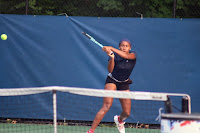Last week, Shira and I celebrated Thanksgiving with a delightful trip to Death Valley in California (full post coming...eventually). While purchasing provisions in Las Vegas, we realized that with a bit of careful shopping we could pick up a portable Thanksgiving feast. We grabbed hot dogs, buns, pickles, mustard, a cooling rack and a two-pack of Sterno fuel. When Thanksgiving arrived, we positioned the cooling rack using a few handy rocks over the can of fuel and cooked the hots with a field expedient grill. The meal was delish!
We had evidence this would work, as we cooked hot dogs over Sterno on a secluded beach in Puerto Rico. That time, we used coconuts as rocks weren't handy. We got by without a grill by wrapping the dogs in aluminum foil.
Turns out, the Sterno company thinks that cooking over Sterno isn't such a crazy idea, and offers a cheap folding stove so you can do this on the go without having to improvise.
A Travel Friendly Solution
This got me thinking: if we were traveling to a destination that we knew had Sterno, we could easily pack or pickup basic supplies to make cooking simple affair. But, what if the destination we have in mind doesn't have Sterno? Or, we don't want to drive around town looking for the stuff? TSA is a hard no when it comes to flying with any fuel, so you can't bring the cans with you.
Looking around for other cooking ideas, it occurred to me that we could consider the humble tea light. This begs the question: can you cook hot dogs over tea lights? Tea lights are TSA safe, portable and easy to travel with. But, do they generate enough heat to make a quality dog? Last night, Shira and I decided we'd find out.
Getting Fired Up
My first attempt was to spread out a 2 x 4 grid of tea lights, and then make four pillars of two tea lights each to rest the grill on. I lit the candles and tossed the doggies on:
Within moments, parts of the hot dogs turned black. In my attempt to make as hot a setup as possible, I'd put the dogs too close to the candles. The result wasn't burned hot dogs, but rather dogs covered in candle soot. I wiped off the doggies and tried again, this time elevating them further from flame by using four baking ramekins. This did the trick nicely. The dogs sizzled away and didn't accumulate soot. Holding our meat thermometer between the dogs showed temps as high as 300°F. So apparently, the candles gave off plenty of heat.
It took about 12 minutes to cook the hot dogs, though Shira wasn't impressed with how carefully I turned them to avoid any charring. But when we finally ate the dogs, they were hot all the way through and quite tasty.
I experimented a bit with making a sort of aluminum foil tent over the hot dogs, attempting to capture some of the heat being lost to the room. Ultimately, I think this wasn't necessary, but it seems like this approach could be used to get a more oven like effect than just cooking over the flame. I'd also like to try placing the tea lights in the bottom of a meatloaf shaped pan with the grill on top. I wonder if that configuration would also capture more heat than having the tea lights in the open.
The main lesson learned from experiment is: be patient. The setup seems improbable, but give it time. The tiny tea lights will produce plenty of heat, so don't rush the process. We're talking slow roasting here, not 30 seconds in the microwave.
I'm looking forward to our next travel adventure where hot dogs are on the menu. It's powerful stuff knowing that 8 tea lights, a bit of foil and some ingenuity is all that's standing between us and a gourmet meal.





































































